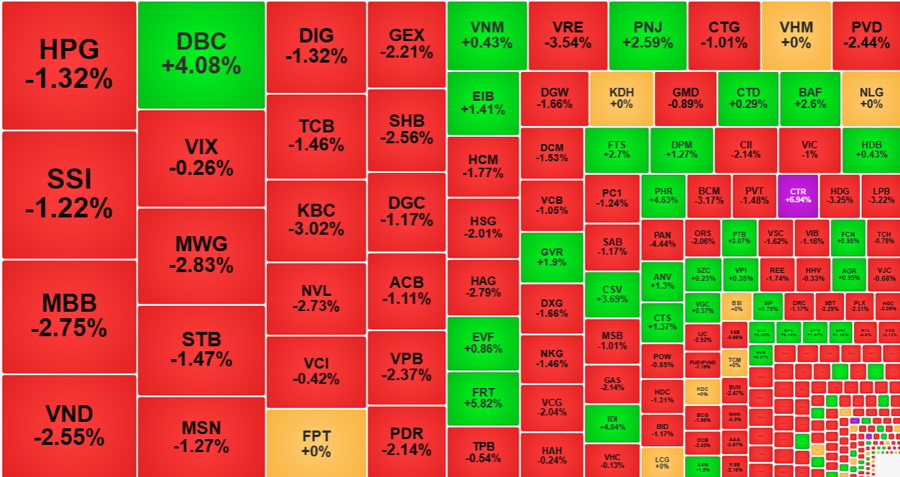The market has lost the fragile balance of the morning session, with new loss-making stocks accepting heavy price cuts to exit. The order matching liquidity on both exchanges this afternoon increased by 50% compared to the morning session, with the VN-Index dropping to its lowest point of the day with red stocks outnumbering green stocks by 3.7 times.
The sharp decline at the end of last week has suddenly pushed a large amount of short-term trading stocks into a loss risk position. The effort to increase leverage suddenly accelerated while the money flow was not ready to buy at higher prices, causing the price level to decline rapidly.
At the end of the morning session, the VN-Index had 44 stocks down more than 1%, while at the end of the afternoon session, that number reached nearly 150 stocks. The breadth also worsened significantly with 106 gainers/392 losers. One signal indicating a particularly large selling pressure is that although HoSE only had 68 stocks declining more than 2%, this group accounted for nearly 31% of the total market value. The most deeply declining stocks in this group, including MBB, VND, MWG, KBC, NVL, GEX, SHB, VPB, PDR, all had trading volume above VND 300 billion. MBB even matched nearly VND 811 billion at a 2.75% decrease.
Obviously, the supporting stocks are the main factor creating pressure. All 10 stocks that caused the most loss to the VN-Index were VN30 stocks. VCB decreased by 1.05%, GAS decreased by 2.14%, VPB decreased by 2.37%, BID decreased by 1.17%, MBB decreased by 2.75%, etc. In fact, this is not only due to market cap, but also purely due to volatility. VRE, BCM, MWG, SHB, BVH, PLX, GAS even fell further. VN30-Index closed down by 1.21%, stronger than the main index’s decrease of 0.95%, and there were only 3 stocks that increased, which were GVR up 1.9%, HDB up 0.43%, and VNM up 0.43%.
Many large stocks plummeted in the afternoon, such as MSN down 3.13% compared to the morning session’s closing price and closed down 1.27% compared to the reference price. MWG alone dropped 2.52% in the afternoon, widening the range to -2.83% compared to the reference price. VRE fell an additional 3.35%, VPB fell an additional 2.11%, BVH fell an additional 2.47%, etc.

In terms of the afternoon session alone, HoSE matched VND 13,461 billion, up 48% compared to the morning session. This trading volume, together with the significantly lower price level, shows that the sellers have taken control. VN-Index plunged by 11.86 points, and in just two days, it lost nearly 30 points and fell back below the level of last September’s peak. Thus, last week’s breakthrough was confirmed to be a “bull-trap” that trapped billions of shares. Sooner or later, this will further increase selling pressure.
In the midst of the selling wave, the market still had some standout stocks that went against the trend. This group also experienced significant selling pressure, but they had strong support from money flows, so they remained in green with high liquidity. Among the 106 stocks that closed above the reference price of the VN-Index, there were 46 stocks that increased by more than 1%. The notable stocks in terms of trading volume were DBC with VND 728.1 billion, up 4.08%; PNJ with VND 289.7 billion, up 2.59%; EIB with VND 247.4 billion, up 1.41%; FRT with VND 210.4 billion, up 4.82%; BAF with VND 108.4 billion, up 2.6%; GVR with VND 172.2 billion, up 1.9%; FTS with VND 160 billion, up 2.7%, etc.
However, this is only a few individual stocks. In the context of the general market correction, the opportunity to go against the trend will still have a high risk because the demand for “penny stocks” will be increasingly high. Moreover, the higher the liquidity of these stocks, the more it shows that investors want to withdraw, and sooner or later the money flow will also gradually narrow down.












